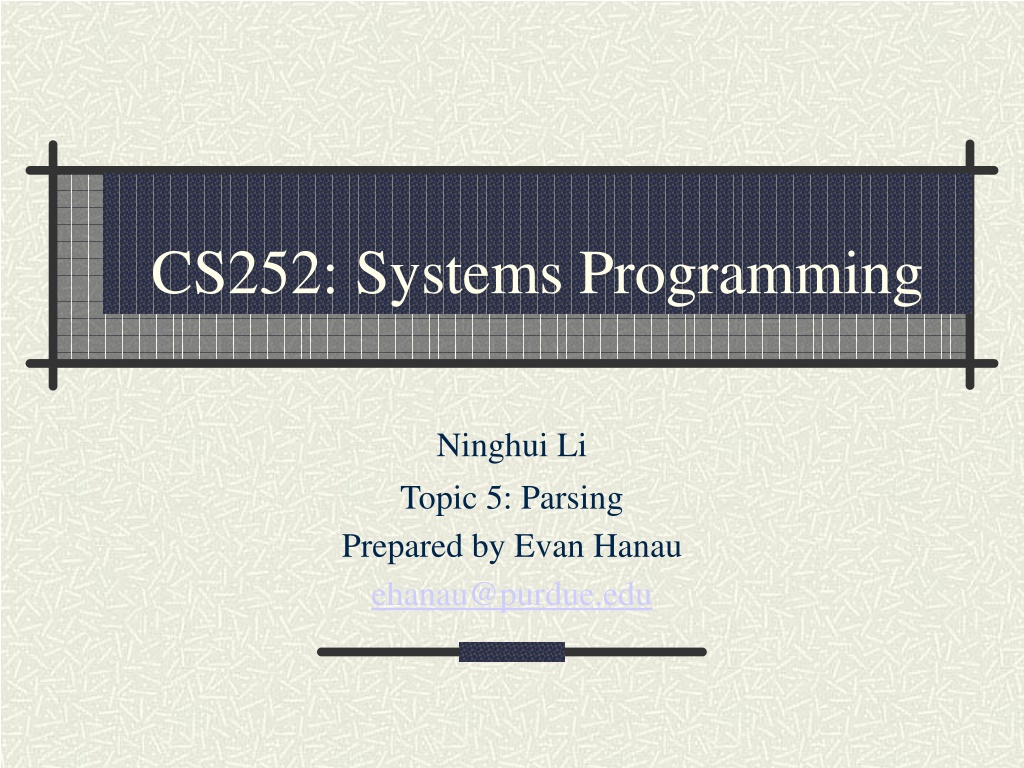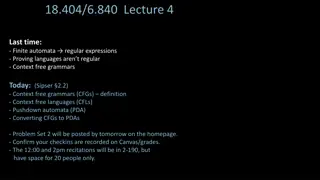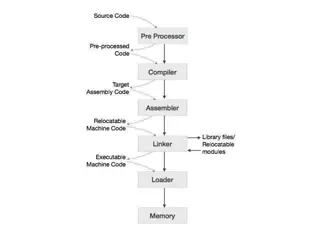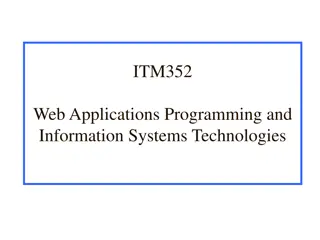Understanding Context-Free Grammars in Systems Programming
This insightful content delves into the world of context-free grammars, explaining their significance in parsing computer programming languages. It discusses the hierarchy of language classification, the limitations of regular expressions in expressing certain constructs like palindromes, and the utility of Backus-Naur Form (BNF) in describing context-free grammars. The included images and examples enhance comprehension of this fundamental topic in systems programming.
Download Presentation

Please find below an Image/Link to download the presentation.
The content on the website is provided AS IS for your information and personal use only. It may not be sold, licensed, or shared on other websites without obtaining consent from the author. Download presentation by click this link. If you encounter any issues during the download, it is possible that the publisher has removed the file from their server.
E N D
Presentation Transcript
CS252: Systems Programming Ninghui Li Topic 5: Parsing Prepared by Evan Hanau ehanau@purdue.edu
Introduction to Parsing with Yacc An Introduction to Parsing with Yacc Context-Free Grammars Yacc Parsing An example Infix Calculator Program
Context-Free Grammar Background: The Context-Free Grammar By CS252 you are already somewhat familiar with Regular Expressions. Regular expressions can be used to describe regular languages, which belong to a larger classification of language types.
Context-Free Grammar In CS, we classify languages on the Chomsky Hierarchy. Type-0 Recursively Enumerable Type-1 Context-Sensitive Type-2 Context-Free Type-3 Regular Type-(i) is a superset of Type-(i+1)
Context-Free Grammar Languages generated by regular expressions belong to type 3. Note: Your specific regular expression engine (e.g. POSIX extended RE) is likely capable of more complex productions. In any case, we need more than regular expressions to parse computer programming languages and shell scripts.
Context-Free Grammar You can do a great deal with regular expressions. Exercise: Create a regular expression that matches on any English phrase that is a palindrome, for instance the string some men interpret nine memos .
Context-Free Grammar This is in fact not possible with regex (by its strict CS definition!). You would be limited to palindromes of a finite length only. RE cannot express anbn , a string with some number of a s followed by equal number of b s The expression a*b* does not require number of a s equal that of b s We must use a context-free grammar to describe palindromes and other constructs. More powerful than a regular expression, and useful when some notion of what came before is required.
Backus-Naur form BNF or Backus-Naur form is used in CS to describe context-free grammars. It is often used to describe the syntax of programming languages.consists of one or more of the following: <nonterminal> ::= __expression__ Where __expression__ consists of one or more terminals and nonterminals or nothing (epsilon).
US Post Address in Backus-Naur form (from wikipedia) <postal-address> ::= <name-part> <street-address> <zip-part> <name-part> ::= <personal-part> <last-name> <opt-suffix-part> <EOL> | <personal-part> <name-part> <personal-part> ::= <first-name> | <initial> "." <street-address> ::= <house-num> <street-name> <opt-apt-num> <EOL> <zip-part> ::= <town-name> "," <state-code> <ZIP-code> <EOL> <opt-suffix-part> ::= "Sr." | "Jr." | <roman-numeral> | "" <opt-apt-num> ::= <apt-num> | ""
Context-Free Grammar for Simple Expressions Let s define a grammar for a primitive add or multiply expression: <expr> ::= <expr> * <expr> | <expr> + <expr> | number In this case, <expr> is a terminal and number, *, and + are the nonterminals.
Context-Free Grammar Clearly, there is some ambiguity here, because operator precedence (sometimes referred to as binding) is not defined. The grammar does not distinguish between 2+2*2+2 = 16 (incorrect under normal rules) or 2+2*2+2 = 8 (correct).
Context-Free Grammar One Solution: Define expressions of different levels: <expr> ::= <add_expr> <add_expr> ::= <add_expr> + <mul_expr> | <mul_expr> <mul_expr> ::= <mul_expr> * number | number Now, multiplication will bind tighter than addition (this may require a few sample expressions to wrap your head around!)
Context-Free Grammar Associativity follows from the above example (Hint: What side of the multiply and add operation did we have the deeper production on?)
CFG for palindrome <palindrome> ::= letter | // empty string <palindrome> ::= a <palindrome> a | b <palindrome> b . Or, <palindrome> ::= letter <palindrome> letter However, we need to check the two letters are the same. CFG for anbn: <anbn> = // empty string | a <anbn> b
Chomsky Hierarchy (From Wikipedia Page) Production rules (constraints) Grammar Languages Automaton Recursively enumerable Type-0 Turing machine (no restrictions) Linear-bounded non-deterministic Turing machine Non- deterministic push down automaton (equivalently, Right side no shorter than left) Type-1 Context-sensitive Type-2 Context-free Finite state automaton Type-3 Regular and
Chomsky Hierarchy Revisited. Type-0 Recursively Enumerable Type-1 Context-Sensitive Cannot encode all strings r1r2 such that r1 and r2 are two regular expressions that are equivalent Type-2 Context-Free (Pushdown Automaton, i.e, Finite State Automaton with a Stack) Can encode anbn, but not anbncn Type-3 Regular (Finite State Automaton) Can encode a*b*, but not anbn
Why is Context-Free Grammar Called Context Free? In a CFG, the left hand of each production is a single non-terminal, e.g., <palindrome> ::= a <palindrome> a This means that a , followed by a <palindrome>, and by a will always be considered as <palindrome>, no matter what is the context, hence context free. In a Context-Sensitive Grammar, left hand of production rules can include other things
An Example Context-Sensitive Grammar for anbncn 1. S a B C 2. S a S B C 3. B C C B 4. a B a b 5. b B b b 6. b C b c 7. c C c c S 2aSBC 1aaBCBC 3aaBBCC 4aabBCC 5aabbCC 6aabbcC 7aabbcc
Yacc & Parsing There are many ways to parse BNF grammars, most of which are discussed in a compilers course. Recall: A finite state automaton (FSA) is used for regular expressions. (CS182). For a context-free grammar, we use a pushdown automaton, which combines features of a FSA with a stack.
Yacc & Parsing Yacc generates what is known as a LALR parser, which is generated from the BNF grammar in your Yacc file. This parser is defined in the C source file that Yacc generates. We use Lex to make a lexer to generate our terminals, which are matched with regular expressions before being fed into the parser.
Yacc & Parsing Input Characters Rule- Based Behavior terminals LEX Lexer YACC Parser Yacc is capable of generating a powerful parser that will handle many different grammars.
Yacc & Parsing Recall that parsing combines a state machine with a stack. States go on a stack to keep track of where parsing is. Yacc uses a parse table which defines possible states. Yacc s parser operates using two primary actions, shift and reduce. shift puts a state on the stack, reduce pops state(s) off the stack and reduces combinations of nonterminals and terminals to a single nonterminal. After a reduction to a rule, Yacc s parser will optionally run some user-defined code.
Yacc & Parsing A very basic example: <rule> := hello world \n The parser would shift each word, successively pushing each state (. hello , . world , . \n ) onto the stack. Then at the end of the rule, reduce everything to <rule> and pop the three states.
A Lex/Yacc Infix Calculator Yacc s parser is powerful, but is not capable of parsing all grammars. Certain ambiguous grammars may produce what is known as a shift/reduce or reduce/reduce conflict. Yacc will, by default, shift instead of reduce.
Yacc & Parsing Consider the classic shift/reduce conflict example: <ifexp> ::= IF <expr> THEN <stmt> ELSE <stmt> | IF <expr> THEN <stmt> Yacc will have a shift/reduce conflict here, but will go with shift (the top option) by default. It s greedy!
A Lex/Yacc Infix Calculator To demonstrate the utility of Lex and Yacc (or in our case, Flex and Bison) we provide an example infix calculator. Similar to several of the examples provided on the Lex and Yacc manpage at http://dinosaur.compilertools.net, but with added features
A Lex/Yacc Infix Calculator Make sure to read ALL source code comments, particularly those that describe source file organization. Lex definition file: calculator.l Yacc grammar file: calculator.y AST Classes: ast.cc Symbol table: symtab.cc
A Lex/Yacc Infix Calculator The example calculator application uses Lex and Yacc to parse mathematical expressions and produce an Abstract Syntax Tree, which is then used to evaluate those expressions. It allows the =, +, *, -, +, ^, () and unary minus operators, with appropriate levels of binding and precedence. Examine calculator.y, because it is heavily commented.
A Lex/Yacc Infix Calculator The symbol table (implemented here in simple O(n) access time) maps variables to values. Print the AST after every expression evaluation by running calculator with the t flag, e.g. calc t .
A Lex/Yacc Infix Calculator A calculator example. Type 2*2^3/3 and press enter: calc> 2*2^3/3 = 5.333333 3.000 / (/) \ 3.000 / (^) \ 2.000 / (*) \ 2.000
Review What are required: Able to write simple Context Free Grammars, similar to those used in implementing FIZ Able to determine whether a string of tokens is accepted by a grammar Able to show how a string of tokens is parsed into some non-terminal (i.e., draw the parsing tree)























